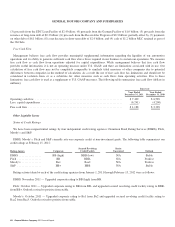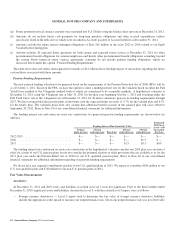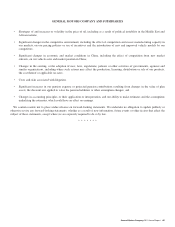General Motors 2011 Annual Report Download - page 60
Download and view the complete annual report
Please find page 60 of the 2011 General Motors annual report below. You can navigate through the pages in the report by either clicking on the pages listed below, or by using the keyword search tool below to find specific information within the annual report.GENERAL MOTORS COMPANY AND SUBSIDIARIES
Refer to Note 18 to our consolidated financial statements for the weighted-average discount rate used to determine net OPEB
expense.
Valuation of Deferred Tax Assets
We establish and Old GM established valuation allowances for deferred tax assets based on a more likely than not standard. The
ability to realize deferred tax assets depends on the ability to generate sufficient taxable income within the carryback or carryforward
periods provided for in the tax law for each applicable tax jurisdiction. We consider and Old GM considered the following possible
sources of taxable income when assessing the realization of deferred tax assets:
• Future reversals of existing taxable temporary differences;
• Future taxable income exclusive of reversing temporary differences and carryforwards;
• Taxable income in prior carryback years; and
• Tax-planning strategies.
The assessment regarding whether a valuation allowance is required or should be adjusted also considers all available positive and
negative evidence factors, including but not limited to:
• Nature, frequency, and severity of recent losses;
• Duration of statutory carryforward periods;
• Historical experience with tax attributes expiring unused; and
• Near- and medium-term financial outlook.
It is difficult to conclude a valuation allowance is not required when there is significant objective and verifiable negative evidence,
such as cumulative losses in recent years. We utilize a rolling three years of actual and current year anticipated results as the primary
measure of cumulative losses in recent years.
The evaluation of deferred tax assets requires judgment in assessing the likely future tax consequences of events that have been
recognized in our financial statements or tax returns and future profitability. Our accounting for deferred tax consequences represents
our best estimate of those future events. Changes in our current estimates, due to unanticipated events or otherwise, could have a
material effect on our financial condition and results of operations.
Though objective and verifiable negative evidence continues to outweigh positive evidence in jurisdictions with significant
valuation allowances, we are experiencing positive evidence trends in certain of these jurisdictions. South Korea operations have
overcome adjusted three-year cumulative losses due to recent profitability. However, a number of negative evidence factors continue
to affect the need for a valuation allowance such as economic and industry uncertainty and limited carryforward lives of key tax
attributes. After reviewing all factors, if additional positive evidence becomes available, we may reverse some or all of our South
Korean valuation allowance in the future. At December 31, 2011 the deferred tax valuation allowance for South Korea was $0.8
billion.
U.S. and Canadian operations are also experiencing current profitability, but these operations remain in cumulative three-year loss
position at December 31, 2011. To the extent this profitability trend continues, it is reasonably possible our conclusion regarding the
need for full valuation allowances could change, resulting in the reversal of some or all of the valuation allowances. At December 31,
2011 deferred tax asset valuation allowances for the U.S. and Canada were $36.4 billion and $3.2 billion.
In a valuation allowance environment, utilization of tax attributes to offset taxable income reduces the overall level of deferred tax
assets subject to valuation allowance. Additionally, our recorded effective tax rate is lower than the applicable statutory tax rate, due
primarily to income earned in jurisdictions for which a full valuation allowance is recorded. Our effective tax rate will approach the
58 General Motors Company 2011 Annual Report
























